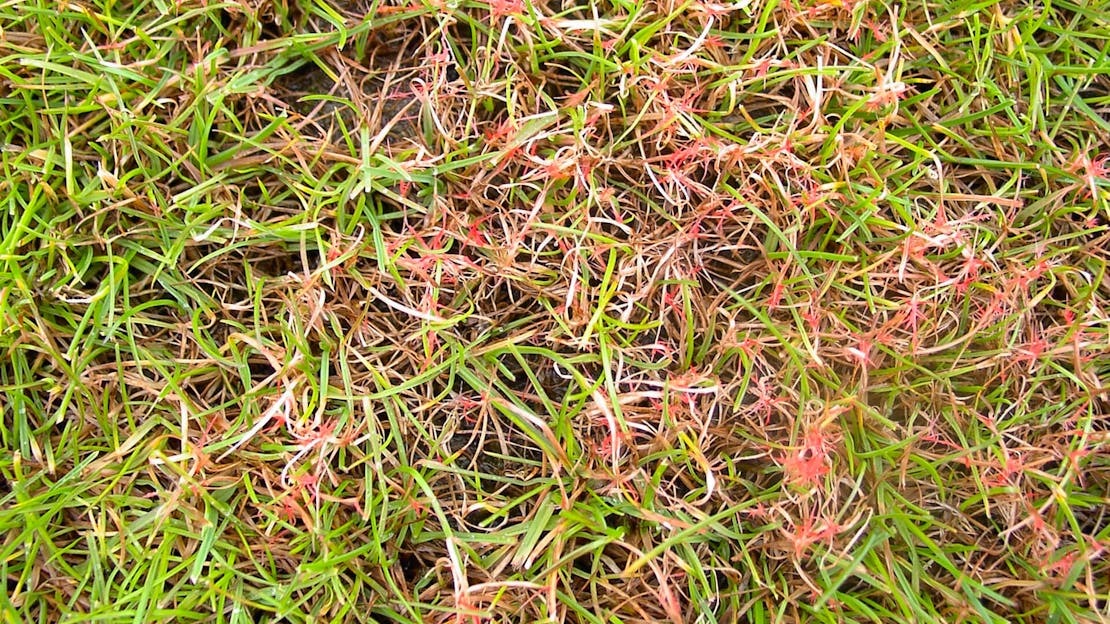
Red Thread & Pink Patch
Of all grass diseases red thread lawn fungus is the most common causing brown patches or a blotchy appearance. The blotches will have a pink colouration
Associated with humid conditions usually from May onwards
Of all grass diseases red thread lawn fungus is the most common. In fact I would pretty much bet that your lawn has it every year and you more than likely have never noticed.
The disease or fungus causes the grass leaf (not the grass plant) to die often giving the lawn a blotchy appearance. Whilst the disease is active the blotches will have a pink colouration and on closer inspection you will see 2mm long pink threads or needles as in the close-up above.
Red thread attacks from May onwards favouring humid and mild weather. Early and late summer temperatures with a dewy grass are ideal though the drying effect of summer on your lawn can disguise the disease leading most people to assume wrongly that the lawn is just suffering from drought as in the image below.

Very wet summers also present ideal conditions. In these years the red thread fungus has been very obvious as the pinky or orangy blotches have formed in otherwise healthy green lawns.
Red thread is often accompanied by another disease or fungus known as pink patch. This appears at the same time but presents itself as tiny pin head size blobs a bit like candy floss.
Finally, some lawns will be affected more than others. The following conditions may increase severity of attack:
- Old or compacted lawns
- Young lawns that have not had chance to build up resistance
- Lawns that become stressed due to drought, heat or water logging
- Lawns that have little air movement and hold the dew well into the day
- Lawns that are watered – light frequent watering in the evening in warm weather will guarantee an attack!
- Late spring scarifying thereby weakening the grass and making it more susceptible to an early summer disease
Remedy
The most important control measure, used by green keepers world wide, is to maintain a good supply of nitrogen in the turf to promote growth. This enables the disease to be mowed out. A fertiliser containing some potassium as well is often preferable. Any of the Lawnsmith Spring & Summer Fertilisers will provide the correct nutrients and have sufficient strength. Occasionally an attack can occur late in autumn in which case you should use our Autumn Fertiliser.
If you are between treatments and there is good moisture in the soil consider bringing forwards your next treatment if the previous treatment appears to be waning or use a soluble fertiliser. Soluble fertilisers are around 20% of the strength of a granular feed so can be used within a few weeks of a granular feed without risk of serious over fertilising. It can be repeated after 4 weeks so that you can extend feeding up to the time of your next granular feed. See How to use Soluble Fertiliser.
There are no recommended mowing heights to help control red thread so we suggest mowing according to the one third rule as usual and in accordance with our article on mowing height. In addition:
- Remove clippings after mowing
- If you water, water deeply and infrequently and only if conditions start to dry
- Do NOT water in the evenings
- Do NOT scarify - you'll increase the severity and spread it further
- Anything you can do to improve drying will help e.g. reduce shade, improve air flow, squeegee the moisture off the lawn by brushing or dragging a garden hose across it etc
- Once the disease has ceased aerate and possibly scarify the lawn to improve drying and remove thatch that harbours fungal spores
Though fungicides are available you are going to need to be on the ball as treatment prior to attack is the best way to control this disease. Treat too early and the fungicide runs out of steam and too late defeats the object. This means the skills of a green keeper are required which makes treatment a problem!
Add to that, you will need to treat several times in a year and as treatment prevents the grass building up its own resistance to the disease you will get locked into an annual cycle of treatments. Personally I wouldn’t bother and just do your best with good lawn care practices and a well timed dose of fertiliser to reduce its impact. Once conditions improve the lawn will recover with no lasting damage.